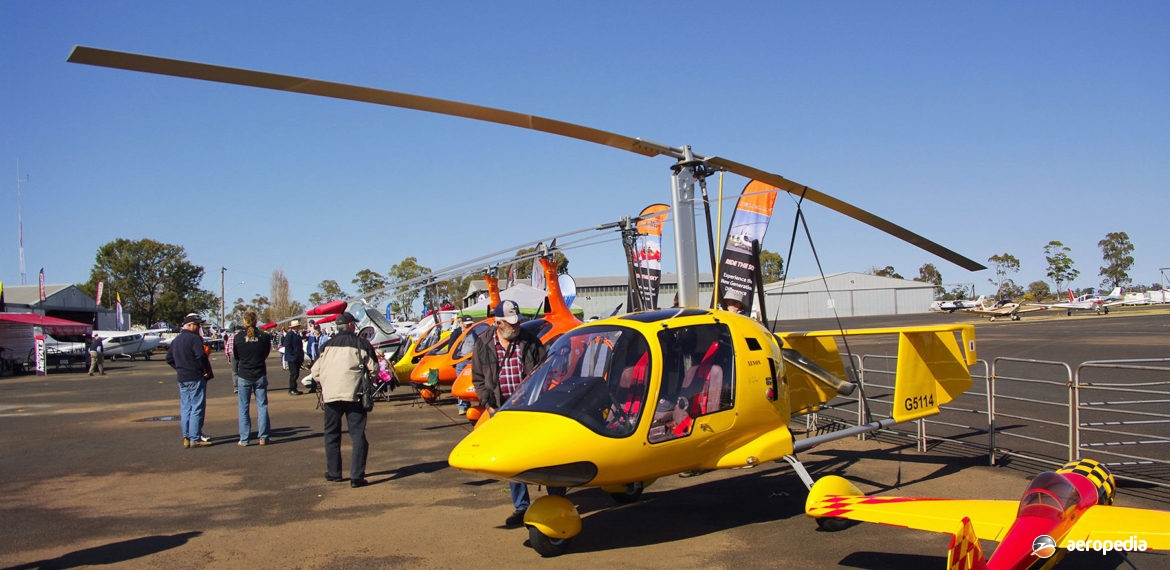Photograph:
ABS Aerolight Xenon G-5114 at Narromine, NSW in 2012 (David C Eyre)
Country of origin:
France
Description:
Two-seat light sport gyrocopter
Power Plant:
One 86 kw (115 hp) Rotax 914 four-cylinder, four-stroke, liquid-and-air-cooled dual-carburetted turbocharged electronic dual ignition engine
Specifications:
- Rotor diameter: 8.4 m (27 ft 6 in)
- Cabin width: 1.2 m (3 ft 10 in)
- Total width: 2.2 m (7 ft 2 in )
- Length: 4.9 m (16 ft)
- Height: 2.8 m (9 ft 2 in)
- Max speed: 195 km/h (121 mph)
- Cruising speed: 160 km/h (99 mph)
- Minimum speed: 27 km/h (17 mph)
- Max climb rate: 366 m/min (1,200 ft/min)
- Service ceiling: 3,658 m (12,000 ft)
- Endurance: 4 hours plus reserve
- Take-off run 10 to 150 m: (3 to 492 ft)
- Landing run 0 to 10 m: (0 to 33 ft)
- Fuel capacity: 88 litres (19.3 Imp gals)
- Empty weight: 285 kg (628 lb)
- Loaded weight: 600 kg (1,323 lb)
History:
The Xenon was developed in France in 2005 and was a factory-built and delivered fully-assembled gyrocopter produced by ABS Aerolight with a variety of Rotax aircraft engines. It was a two-seat machine with an enclosed and heated cabin. It had a luggage compartment and full instrumentation. It has been said to be safe, stable and easy to fly. It was a modern gyrocopter using new technology and materials and had a composite self-supporting cell with reinforcements at each stress point. It had a high tail which allowed for a greater angle of rotation and flaring. There were large windows in each door, and a wrap-around windshield for optimum visibility.
The mechanical pre-rotator system was capable of bringing the rotor up to 280 to 300 rpm to allow the machine to take-off in a short distance. Engines installed were usually from the Rotax range, and included the 75 kw (100 hp) Rotax 912S, the 86 kw (115 hp) Rotax 914 and the 91 kw (122 hp) Rotax 912RST, or a Hirth F30 unit of 76 kw (102 hp), driving a three-blade DUC Windspoon propeller or a Kevlar/carbon Ivoprop unit. The rotor was an Aircopter unit of extruded aluminium and was available with a diameter of 8.4 m (27 ft 6 in) or 8.8 m (28 ft 10 in). Fuel was carried in two interconnected fuel tanks.
Early Xenons were built by ABS Aerolight in France and were powered by Hirth engines. Approximately 15 were built and most were supplied as kits. By 2007 production had moved to to a new facility in Poland and 145 had been completed by the end of 2011. From 2012 it was in production in two facilities, one with Aviation Artur Trendak at Jaktorow-Koloneo in Poland as the Zen I, and from 2014 further development culminated in the Tercel and Taurus variants. A further facility built machines at Piotrokow, also in Poland, where it became known as the Xenon IV.
A number of examples have been imported to this region, the distributor being Xenon Gyroplane of Charters Towers, QLD, this company commencing operations in 2006 and assembling and flying its first machine in early 2008. Australian examples include Tercels G-1960, G-5110, G-5111, G-5112 (c/n AK-09373S), G-5113 (CAK-09573S), G-5114 (c/n CAA-10374R), G-5115, G-5116, G-5117, and G-5118; and Zen Is G-5119 and G-5120.
The first three registered in New Zealand became ZK-XEN (c/n NZX03), ZK-XJE (c/n NZX02) and ZK-ZMY (c/n NZX01), the first two registered to Gyrate NZ Ltd of Mount Maunganui, and the third to Mr J P Rochford of Porirua, NZ.

